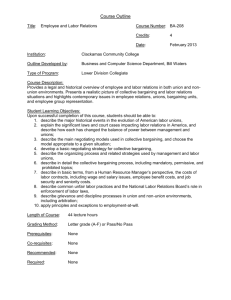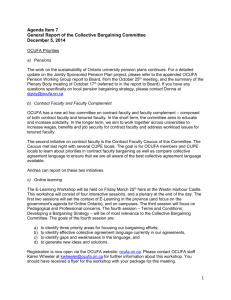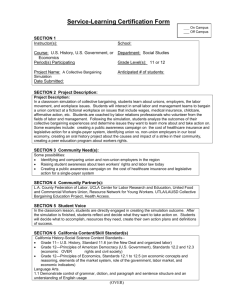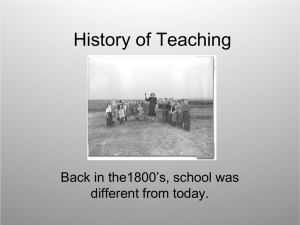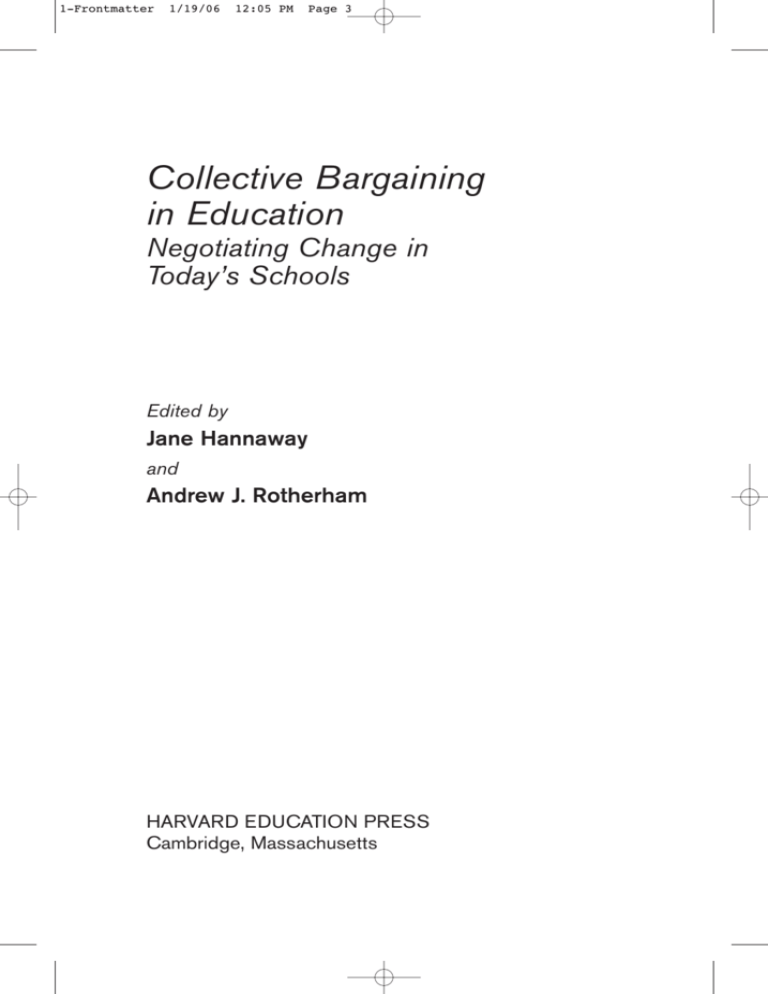
1-Frontmatter
1/19/06
12:05 PM
Page 3
Collective Bargaining
in Education
Negotiating Change in
Today’s Schools
Edited by
Jane Hannaway
and
Andrew J. Rotherham
HARVARD EDUCATION PRESS
Cambridge, Massachusetts
1-Frontmatter
1/19/06
12:05 PM
Page 4
Copyright © 2006 by the President and Fellows of Harvard College
All rights reserved. No part of this publication may be reproduced or transmitted in
any form or by any means, electronic or mechanical, including photocopy, recording,
or any information storage and retrieval systems, without permission in writing from
the publisher.
Library of Congress Control Number 2005937616
Paperback 10-digit ISBN 1-891792-71-7
Library Edition 10-digit ISBN 1-891792-72-5
Paperback 13-digit ISBN 978-1-891792-71-7
Library Edition 13-digit ISBN 978-1-891792-72-4
Published by Harvard Education Press,
an imprint of the Harvard Education Publishing Group
Harvard Education Press
8 Story Street
Cambridge, MA 02138
Cover Design: Anne Carter
The typefaces used in this book are Berthold Akizdenz Grotesk and Sabon.
1-Frontmatter
1/19/06
12:05 PM
Page 5
Table of Contents
INTRODUCTION . . . . . . . . . . . . . . . . . . . . . . . . . . . . . . . . . . . . . . . . . . . . . . . . . . 1
Jane Hannaway and Andrew J. Rotherham
CHAPTER ONE . . . . . . . . . . . . . . . . . . . . . . . . . . . . . . . . . . . . . . . . . . . . . . . . . . . 7
The History of Collective Bargaining among Teachers
Richard D. Kahlenberg
CHAPTER TWO . . . . . . . . . . . . . . . . . . . . . . . . . . . . . . . . . . . . . . . . . . . . . . . . . . 27
Union Membership in the United States
The Divergence between the Public and Private Sectors
Henry S. Farber
CHAPTER THREE . . . . . . . . . . . . . . . . . . . . . . . . . . . . . . . . . . . . . . . . . . . . . . . 53
Scapegoat, Albatross, or What?
The Status Quo in Teacher Collective Bargaining
Frederick M. Hess and Andrew P. Kelly
CHAPTER FOUR . . . . . . . . . . . . . . . . . . . . . . . . . . . . . . . . . . . . . . . . . . . . . . . . 89
The Costs of Collective Bargaining Agreements
and Related District Policies
Paul T. Hill
CHAPTER FIVE . . . . . . . . . . . . . . . . . . . . . . . . . . . . . . . . . . . . . . . . . . . . . . . . 111
The Effects of Collective Bargaining on Teacher Quality
Susan Moore Johnson and Morgaen L. Donaldson
1-Frontmatter
1/19/06
12:05 PM
Page 6
CHAPTER SIX . . . . . . . . . . . . . . . . . . . . . . . . . . . . . . . . . . . . . . . . . . . . . . . . . 141
Are Teachers Unions Good for Students?
Dan Goldhaber
CHAPTER SEVEN . . . . . . . . . . . . . . . . . . . . . . . . . . . . . . . . . . . . . . . . . . . . . . 159
Teachers Unions and No Child Left Behind
Paul Manna
CHAPTER EIGHT . . . . . . . . . . . . . . . . . . . . . . . . . . . . . . . . . . . . . . . . . . . . . . . 181
The Educational Value of Democratic Voice
A Defense of Collective Bargaining in American Education
Leo Casey
CHAPTER NINE . . . . . . . . . . . . . . . . . . . . . . . . . . . . . . . . . . . . . . . . . . . . . . . . 203
The As-Yet-Unfulfilled Promise of Reform Bargaining
Forging a Better Match between the Labor Relations
System We Have and the Education System We Want
Julia E. Koppich
CHAPTER TEN . . . . . . . . . . . . . . . . . . . . . . . . . . . . . . . . . . . . . . . . . . . . . . . . . 229
Union Power and the Education of Children
Terry M. Moe
CONCLUSION . . . . . . . . . . . . . . . . . . . . . . . . . . . . . . . . . . . . . . . . . . . . . . . . . 257
Jane Hannaway and Andrew J. Rotherham
NOTES . . . . . . . . . . . . . . . . . . . . . . . . . . . . . . . . . . . . . . . . . . . . . . . . . . . . . . . . 267
ABOUT THE CONTRIBUTORS . . . . . . . . . . . . . . . . . . . . . . . . . . . . . . . . . . 301
INDEX . . . . . . . . . . . . . . . . . . . . . . . . . . . . . . . . . . . . . . . . . . . . . . . . . . . . . . . . 305
2-Introduction
1/18/06
9:51 PM
Page 1
Introduction
JANE HANNAWAY
ANDREW J. ROTHERHAM
his volume had its beginnings in a casual sidebar conversation at a conference on what seemed to be an unrelated topic. Our discussion was
wide ranging, but it ended up on teacher collective bargaining and the
promise and perils it holds for advancing education in the United States. We
came to realize that much about school reform is directly or indirectly related
to teacher collective bargaining. We then compared notes about what we knew
from research about collective bargaining and who was pursuing the topic in an
analytic way. Despite the work of a few well-known figures, the landscape was
sparsely populated. We could think of many critics and many apologists, but
few objective analysts. We could also come up with the standard rhetorical
arguments, claims, and counterclaims, but little in the way of reasoned arguments or solid empirical evidence. So we decided to bring together the people
who had systematically studied the area, others who had well-articulated views
about collective bargaining, and several more respected education researchers
and analysts to produce this volume. We added to this mix some of the most
well-respected thinkers in the American Federation of Teachers (AFT) and the
National Education Association (NEA) as well as leading analysts, researchers,
and practitioners, all of whom we convened in Washington, D.C., for a dayand-a-half discussion centered on the papers our experts produced.
This volume and the conference that preceded it show the disappointing
polarization that characterizes discussion of these vital issues as well as the profound lack of relevant data, research, and analysis. However, this effort also
serves as an important first step in greater examination of these issues and dialogue about them. The conference brought together scholars, partisans, and
educators for discussion. Many of the participants had never been in the same
T
1
2-Introduction
1/18/06
9:51 PM
Page 2
2 COLLECTIVE BARGAINING IN EDUCATION
room together, despite being longtime antagonists. There was much important
and honest exchange of reasoned argument and a clear delineation of the
important issues that give rise to debate.
The topic of this volume is timely. The labor movement in the United States
is at a critical juncture because of dramatic changes in the U.S. economy—especially the move to a service economy, increased globalization, and increased
household income. To be sure, organized labor will likely always be an important player in economic and social decisionmaking in this country, but its role
will evolve to fit today’s environment, just as the role of other societal institutions evolves over time. But what about public-sector unions, in particular the
most powerful among them, the teachers unions? Are they subject to the same
pressures? How are they similar to and different from private-sector unions?
And how are professional unions and professional bargaining similar to and
different from bargaining by other groups? These are some of the questions our
contributors address.
Most importantly and most centrally, we are concerned here with describing
the role that collective bargaining has played over the years for teachers and the
influence it has had on education more generally. Like the economy, education
is at a critical juncture. State and national accountability requirements, the poor
performance of many U.S. students relative to students in other industrialized
countries, and great academic achievement gaps among different student
groups within the United States have combined to exert performance pressure
on schools like never before. These are conditions far different from those 40
years ago, when teacher collective bargaining developed. It is vital that policymakers understand what role collective bargaining currently plays to advance
or constrain reforms intended to promote student achievement, and what role
it might play in the future.
We should be clear that our intent is not to play the role of advocate or
antagonist. We do not know all the answers; indeed, we are first trying to sort
out the relevant questions. What is apparent is that collective bargaining by
teachers is a key part of the scaffolding of education in the United States. We
attempt to lay out systematically what we know and what we do not know
about its role and its effects on student performance and school reform efforts.
The first three chapters lay the groundwork for those that follow. In chapter
1, Richard D. Kahlenberg describes how the adoption of collective bargaining in
the 1960s changed the AFT and the NEA from “sleepy organizations” to “the
most powerful forces in education” as well as potent actors in the national political arena. He also discusses attempts, especially those of the AFT president
Albert Shanker, to direct union and collective bargaining efforts beyond the stan-
2-Introduction
1/18/06
9:51 PM
Page 3
INTRODUCTION 3
dard working-condition issues that concern all unions to professional issues of
practice and policy. In much of the volume, the teachers unions are referred to
generically—and they do indeed have a great deal in common—but in fact the
AFT and the NEA are different organizations that at times pursue different
objectives or employ different strategies, as Kahlenberg demonstrates.
In chapter 2, Henry S. Farber shows the sharp divergence in the fortunes of
private- and public-sector unions in recent decades. In the early 1970s about 1
in 4 public- and private-sector employees was a member of a union; today more
than 1 in 3 employees in the public sector belongs to a union, but only about 1
in 12 employees in the private sector. A big part of the public-sector increase is
among local government employees, especially teachers. Farber suggests this
public/private divergence is likely due to the greater advantages that publicsector unions, representing services typically unconstrained by market pressure
and more open to political activity, can offer their members. Farber also discusses essential differences between public- and private-sector unions that are
key to making sense of the issues this volume addresses.
Chapter 3, by Frederick M. Hess and Andrew P. Kelly, provides an inside
look into collective bargaining by analyzing the legal framework and dynamics
of the bargaining process as well as the agreements themselves. The evidence the
authors present suggests that claims that unions completely restrict district
management may be overstated. Hess and Kelly point out that district management is also party to contract terms, and they further suggest that administrators and school board members may sometimes use the collective bargaining
agreement “as an excuse for inaction” beyond constraints in the agreements
themselves.
We commissioned the next four chapters to review research on the effects of
collective bargaining. Chapter 4, by Paul T. Hill, looks at the cost implications
of collective bargaining and who bears those costs. His conclusions do not paint
a pretty picture, and, like Hess and Kelly, he suggests that school boards and
district administrators are part of the problem, as well as the bargaining agreements themselves. Common terms of collective bargaining agreements—overall
increases in teacher pay scale, raises linked to seniority, salary credit for continuing education, and limits on class size and student contact minutes—create
natural cost escalators. Over time these built-in escalators have had dramatic
effects on school district costs that become serious problems, especially when
districts run into financial difficulties. But more worrisome is Hill’s discussion
of how collective bargaining agreements tend to short shrift struggling schools
serving disadvantaged children in the most important in-school resource, highquality teachers.
2-Introduction
1/18/06
9:51 PM
Page 4
4 COLLECTIVE BARGAINING IN EDUCATION
Chapter 5, by Susan Moore Johnson and Morgaen L. Donaldson, attempts
to address the relationship between teacher quality and collective bargaining.
The authors explain why it is difficult to sort out the connection, partly because
of the tremendous variation in labor policies and practices from state to state
and district to district, but they bring to bear the available research to shape and
inform the important questions. Do pay policies, including the single-salary
schedule, attract or drive out effective teachers? Do agreements include provisions that might support effective teaching, for example, class size and time for
preparation? Do teacher assignment terms ensure “fair and wise assignment, or
. . . give undue weight to teachers’ preferences and seniority, thus limiting some
students’ access to experienced teachers?” Do contracts establish reasonable
means for professional evaluation, or do they protect poor teachers? Do agreements limit the professional influence of teachers or promote it?
The ultimate question of interest, of course, is the effect of collective bargaining on student achievement. Dan Goldhaber reviews the available research literature in chapter 6. In short, the research is sparse at best, and firm conclusions are not warranted one way or the other. Chapters 5 and 6 make all too
clear that collective bargaining has unfortunately not been the focus of much
systematic inquiry by scholars and policy analysts, despite its centrality to education.
We noted earlier that the education policy context today is different from
what it was when collective bargaining first took root. One major difference is
the teacher labor market. When teacher collective bargaining was established,
schools still had a largely captive labor market because few other careers were
open to women. Today, by contrast, competition for high-quality teachers is
strong. A second important difference is the emphasis today on holding schools
accountable for student outcomes. Chapter 7, by Paul Manna, examines the
relationship between teachers union interests and the federal No Child Left
Behind Act (NCLB), which requires states to conduct annual testing of students
and to hold schools accountable for results. It also requires that schools hire
highly qualified teachers in core subjects. Manna’s analysis of the union-NCLB
relationship provides an early glimpse into the possible fault lines and points of
convergence between teachers unions and the new policy environment.
To help readers understand the major contours of the debate about these
issues, the authors of the last three essays were invited to argue particular
points. In chapter 8 Leo Casey of the United Federation of Teachers in New
York was asked to make the case for why collective bargaining by teachers is
beneficial in American education. He argues that what is in the common interest of teachers as educators is also in the best interest of students; the working
2-Introduction
1/18/06
9:51 PM
Page 5
INTRODUCTION 5
environment of teachers is the learning environment of students. Julia E.
Koppich, one of the few scholars who has studied teachers unions systematically, takes a “mend it don’t end it” position and focuses chapter 9 on the promise and pitfalls of what has become known as “reform unionism,” in which
unions are involved in negotiating professional issues and not just issues associated with traditional industrial unionism. Koppich argues that changes may
be needed in collective bargaining laws to ensure effective reform unionism and
to bring about labor-management relations better suited to the current demands
of education. In chapter 10 Terry M. Moe, also a scholar of unions, argues that
it is unreasonable to expect unions to reform themselves in ways that make education for children their priority. Unions should be expected to behave in the
same way that other organizations behave—that is, to promote their own interests. If the education system is to evolve in ways that truly promote the education of children, union power over schools should be weakened or eliminated,
Moe argues.
A significant part of our discussion in the concluding chapter focuses on the
need for not only more analysis and research but also—perhaps even more
importantly—the need for greater transparency and broader involvement in the
negotiating process itself and the political process that surrounds it. The consequences of collective bargaining are important both in terms of the allocation
of significant public dollars and in the effective operation of the public school
system for children. The stakes are simply too high to continue to ignore this
integral part of the daily operations of many public schools and school districts.
We have many people to thank for helping us put this volume together. The
first thanks should go to the authors for their work, which forms the backbone
of this undertaking. A major thanks is also due the discussants who participated in the conferences and critiqued the papers that were delivered. Their comments led to revisions of papers in ways that made them fuller, more nuanced,
and more accurate. Their feedback and expertise also helped to guide the discussion and debate at the conference in fruitful ways. The discussants included
Joan Baratz Snowden, AFT; Kate Walsh, National Council on Teacher Quality;
Harry Holzer, Georgetown University; Michelle Rhee, the New Teacher Project;
Janet Hansen, RAND; Martin West, Harvard University; Russlyn Ali, The
Education Trust; William Raabe, NEA; Jennifer King Rice, University of
Maryland; Chester Finn, Fordham Foundation; and Thomas Mooney, Ohio
Federation of Teachers. We are also grateful to Alan Bersin, former superintendent of San Diego schools, for his forthright discussion of his frontline experiences with unions as he headed one of the most ambitious school reform efforts
in the country. Bersin is now California’s secretary of education. Charles
2-Introduction
1/18/06
9:51 PM
Page 6
6 COLLECTIVE BARGAINING IN EDUCATION
Kerchner, a noted scholar of teachers unions, commented on Bersin’s discussion
and provided additional insights into collective bargaining laws and their
reform. Many other attendees were active in discussions, providing views and
information to us and to authors both during and after the conference, and we
are grateful to them as well.
Much behind-the-scenes support was necessary to produce this volume. Will
Marshall, Sara Mead, and Renee Rybak of the Progressive Policy Institute provided valuable advice and support. At the Urban Institute, Irene Steward organized the logistics of the conference and kept all the trains running on time, and
Danny Loss tied up all the loose ends for final production of this volume. Stu
Kantor of UI’s Communication Division provided helpful advice and support
for the conference.
Finally, we gratefully acknowledge the support provided by The Broad
Foundation and the Smith Richardson Foundation. This project would not have
been possible without their willingness to provide philanthropic support to
examine this important and controversial issue. We’re also grateful to Harvard
Education Press for its uncompromising professionalism and top-flight support.

![Labor Management Relations [Opens in New Window]](http://s3.studylib.net/store/data/006750373_1-d299a6861c58d67d0e98709a44e4f857-300x300.png)

